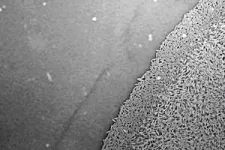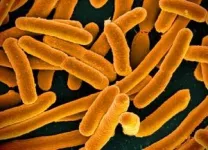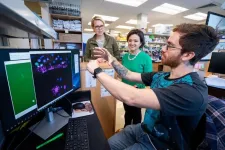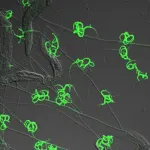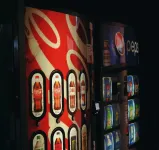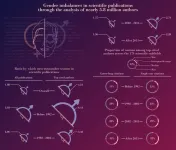(Press-News.org) Scientists have discovered that bacteria can create something like memories about when to form strategies that can cause dangerous infections in people, such as resistance to antibiotics and bacterial swarms when millions of bacteria come together on a single surface. The discovery — which has potential applications for preventing and combatting bacterial infections and addressing antibiotic-resistant bacteria — relates to a common chemical element bacterial cells can use to form and pass along these memories to their progeny over later generations.
Researchers at The University of Texas at Austin found that E. coli bacteria use iron levels as a way to store information about different behaviors that can then be activated in response to certain stimuli.
The findings are published in the Proceedings of the National Academy of Sciences.
Scientists had previously observed that bacteria that had a prior experience of swarming (moving on a surface as a collective using flagella) improve subsequent swarming performance. The UT-led research team set out to learn why. Bacteria don’t have neurons, synapses or nervous systems, so any memories are not like the ones of blowing out candles at a childhood birthday party. They are more like information stored on a computer.
“Bacteria don’t have brains, but they can gather information from their environment, and if they have encountered that environment frequently, they can store that information and quickly access it later for their benefit,” said Souvik Bhattacharyya, the lead author and a provost early career fellow in the Department of Molecular Biosciences at UT.
It all comes back to iron, one of the most abundant elements on Earth. Singular and free-floating bacteria have varying levels of iron. Scientists observed that bacterial cells with lower levels of iron were better swarmers. In contrast, bacteria that formed biofilms, dense, sticky mats of bacteria on solid surfaces, had high levels of iron in their cells. Bacteria with antibiotic tolerance also had balanced levels of iron. These iron memories persist for at least four generations and disappear by the seventh generation.
“Before there was oxygen in the Earth’s atmosphere, early cellular life was utilizing iron for a lot of cellular processes. Iron is not only critical in the origin of life on Earth, but also in the evolution of life,” Bhattacharyya said. “It makes sense that cells would utilize it in this way.”
Researchers theorize that when iron levels are low, bacterial memories are triggered to form a fast-moving migratory swarm to seek out iron in the environment. When iron levels are high, memories indicate this environment is a good place to stick around and form a biofilm.
“Iron levels are definitely a target for therapeutics because iron is an important factor in virulence,” Bhattacharyya said. “Ultimately, the more we know about bacterial behavior, the easier it is combat them.”
The research was funded by the National Institutes of Health. Rasika Harshey, a professor of molecular biosciences and Mary M. Betzner Morrow Centennial Chair in Microbiology, is the senior corresponding author on the paper. Nabin Bhattarai, Dylan M. Pfannenstiel and Brady Wilkins, along with Abhyudai Singh of University of Delaware, also contributed to the research.
END
Bacteria store memories and pass them on for generations
2023-11-21
ELSE PRESS RELEASES FROM THIS DATE:
Forest modeling shows which harvest rotations lead to maximum carbon sequestration
2023-11-21
CORVALLIS, Ore. – Forest modeling by Oregon State University scientists shows that a site’s productivity – an indicator of how fast trees grow and how much biomass they accumulate – is the main factor that determines which time period between timber harvests allows for maximum above-ground carbon sequestration.
The findings, published in the journal Forests, are important for Pacific Northwest forest managers seeking to strike an optimal balance between harvesting and carbon sequestration, an important tool in the fight against climate change.
The study by Catherine Carlisle, Temesgen Hailemariam ...
The bilingual brain may be better at ignoring irrelevant information
2023-11-21
People who speak two languages may be better at shifting their attention from one thing to another compared to those who speak one, according to a study published this month in the journal Bilingualism: Language and Cognition.
The study examined differences between bilingual and monolingual individuals when it comes to attentional control and ignoring information that isn’t important at the time, said its authors Grace deMeurisse, a University of Florida Ph.D. candidate studying linguistics, and Edith Kaan, ...
Promising target for CAR T cells helps cancer trick the immune system
2023-11-21
(MEMPHIS, Tenn. – November 21, 2023) Findings from St. Jude Children’s Research Hospital are moving the field of cancer immunotherapy one step closer to treating brain and solid tumors. Scientists at St. Jude validated a cellular immunotherapy target called 78-kDa glucose-regulated protein (GRP78) in proof-of-principle experiments. The group also discovered a resistance mechanism whereby some tumors trick the cancer-killing immune cells into expressing GRP78, thereby turning off the immune cells or causing them to be killed, too. The research, which has implications for developing immunotherapy for the broad range of difficult-to-treat ...
Researchers help unravel brain processes involved in vision
2023-11-21
TORONTO, Nov. 21, 2023 – Faced with images that break the expected pattern, like a do not enter sign where a stop sign is expected, how does the brain react and learn compared to being shown images which match what was predicted?
That was the question a team, including York University, set out to answer. A long-standing theory suggests the brain learns a predictive model of the world and its internal predictions are updated when incoming sensory data proves them wrong. However, what the researchers found surprised them, says York Faculty of Science Associate Professor Joel Zylberberg, co-corresponding author of the newly published paper.
“Testing ...
Unearthing how a carnivorous fungus traps and digests worms
2023-11-21
A new analysis sheds light on the molecular processes involved when a carnivorous species of fungus known as Arthrobotrys oligospora senses, traps and consumes a worm. Hung-Che Lin of Academia Sinica in Taipei, Taiwan, and colleagues present these findings November 21st in the open access journal PLOS Biology.
A. oligospora usually derives its nutrients from decaying organic matter, but starvation and the presence of nearby worms can prompt it to form traps to capture and consume worms. A. oligospora is just one of many species of fungi that can trap and eat very small animals. Prior research has illuminated some of the biology behind this ...
Taxing sugar-sweetened beverages in Germany would improve population health and save money
2023-11-21
In Germany, taxing sugar-sweetened beverages could prevent or postpone cases of type 2 diabetes, extend healthy lifespans and save up to €16.0 billion in societal costs over the next 20 years, according to a new study led by Karl Emmert-Fees of the Technical University of Munich, published November 21st in the open access journal PLOS Medicine.
The World Health Organization has recommended that governments worldwide lessen the social and economic burden of cardiometabolic disease by taxing sugar-sweetened beverages. These taxes either reduce consumption by increasing the price, such as the one peso per liter ...
Germany: Sugar tax could save as much as 16 billion euros
2023-11-21
A simulation study conducted by a team from the Technical University of Munich (TUM) demonstrates that a soft drink tax in Germany would have significant positive effects. In all of the simulated variants evaluated, less sugar was consumed and the rate of illness dropped. This would be a way to reduce costs to the national economy and alleviate the burden on the health care system. There is, however, a difference between taxes aimed at reducing soft drink consumption and taxes aimed at bringing about changes in product formulation.
Sugary beverages increase the risk of obesity and illnesses such as diabetes. Several countries have therefore introduced taxes on soft drinks. In Germany ...
Most-cited scientists: still mostly men, but the gender gap is closing
2023-11-21
An analysis of 5.8 million authors across all scientific disciplines shows that the gender gap is closing, but there is still a long distance to go. The new research by John Ioannidis of the Meta-Research Innovation Center at Stanford (METRICs) at Stanford University, US, and colleagues, publishes November 21st in the open access journal PLOS Biology.
There is a strong gender gap in science which manifests itself in many ways. One of the most prominent ones is the relative representation of men and women among the scientists whose work receive the most attention in the ...
New fossil assemblage highlights complexity of classifying silesaurid phylogeny
2023-11-21
A set of fossils recovered in Rio Grande do Sul, Brazil’s southernmost state, has brought an extra layer of complexity to the study of the evolutionary history of silesaurids, a family of dinosauriforms (dinosaurs and their close relatives) that lived in the Triassic period between 247 million and 208 million years ago.
In an article published in the Journal of Vertebrate Paleontology, researchers affiliated with institutions in Brazil and the United States show that even with the new fossil assemblage ...
CRF launches Scientific Excellence Top 10 (SET-10)
2023-11-21
NEW YORK – November 20, 2023 – The Cardiovascular Research Foundation (CRF), in conjunction with the Transcatheter Cardiovascular Therapeutics (TCT) 2023 conference, CRF's annual scientific symposium, announced today the launch of the CRF Scientific Excellence Top 10 (SET-10), a new global annual ranking recognizing academic contributions to interventional cardiovascular medicine.
The SET-10 initiative, aligning with CRF's commitment to advancing the field, aims to recognize and celebrate the extraordinary contributions made by medical and academic ...

